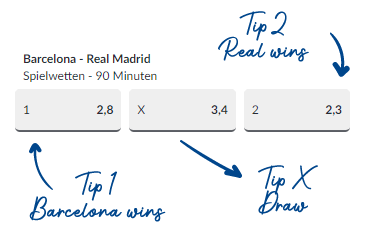What Does 3 Mean In Betting
When it comes to pretty much any topic in life you will likely be on one side or the other. Pineapple on pizza, yes or no? Mustard on hotdogs, yes or no? Should a hot dog be considered a sandwich? And the list of yes or no questions goes on and on. However, these kinds of questions can be debated about until the cows come home and there really are no right or wrong answers. In sports betting, being on a particular side is usually black or white. You’re either on the right side and you win your bet, or you’re on the wrong side and lose it.
What does 'plus' and 'minus' mean as a sports betting term? Odds expressed in terms of money, with $100 being the standard. If the odds are minus (–), then that amount of money must be wagered. What do the + and - mean in sports betting? There are multiple meanings. The most common meaning, particularly in American football and basketball, is a point spread. If point spreads are being discussed, you might see something like “Buffalo +7 a.
What Does Sides Mean?
When you hear someone using the term “side” or “sides” they are referring to the two teams playing against each other in a particular game or event. The simplest example I can give you is if you are looking at an NHL game between the Toronto Maple Leafs and the Vegas Golden Knights. If someone says they are playing a “side” in this game, it means they have a bet on one of these two teams to win the game. In terms of standard types of betting, people will refer to betting sides or betting totals – which we all know is a play on the “over/under” on a game.
How to Bet Sides
Since sides is a way to refer to betting one team over the other, there are multiple options when it comes to betting sides. For example, betting the point spread is the most common way to bet a “side” in football and basketball. However, the point spread is a wager on not only who will win the game, but how much a team will win or lose by.If you wanted to pick a “side” to win the game outright, you would take them on the money line. The problem with just picking a “side” in a point spread sport, is that you would receive a smaller payout for a favorite than you would for picking an underdog.
The money line wager is the most common wager in baseball and hockey, but is also used in sports like tennis, boxing and MMA. There are also options in hockey and baseball called the puck line and run line which is essentially the same bet as a point spread, but with a fixed line of -1.5.
Strategy for Betting Sides
Sure, betting “sides” and trying to determine which side is going to win sounds easy, but it is far from. The biggest mistake square bettors make when handicapping sides is that they always think the better team is going to win. If you’ve ever watched a sport for a couple of days, you will know that is not always the case.
The problem squares come across is when they bet a side on the money line and have to lay the price with the favorite. That price is often time not justifiable with the actually probability the team has to win the game outright. Because of this, you must be sure that there is value in the line before making any bet on any side in any sport.

Doc's Sports is offering $60 worth of handicapper picks absolutely free - no obligation, no sales people - you don't even have to enter credit card information. You can use this $60 credit any way you please for any handicapper and any sport on Doc's Sports Advisory Board list of expert sports handicappers. Click here for more details and take advantage of this free $60 picks credit today .
Point spread betting is the most popular form of sports betting. The vast majority of sports wagers use a point spread thanks to the popularity of football and basketball. Even though this type of betting is so popular, it may take awhile to understand.
The point spread is sometimes known as an equalizer for sportsbook operators. All teams aren’t created equally, so sportsbooks can create a point spread for a game so that each team playing has an almost even chance of winning the game. In a way, the point spread will even the field for both teams.
The point spread gives a reason for bettors to risk money on both teams. The better team playing in the game is considered favorite. They have to win by the point spread offered by the sportsbook. The favorite in a game is listed as being minus (-) the point spread.
The worse of the teams playing in the game is called the underdog. The bettor wins if this team wins the game outright or loses by an amount smaller than the point spread. The underdog in a game is listed as being plus (+) the point spread.
Let’s use this past Super Bowl between the Tampa Bay Buccaneers and Kansas City Chiefs as an example.
Using this example, the Chiefs were 3-point favorites over the Buccaneers. The Chiefs needed to win by 4 or more points to cover the spread.
Likewise, the Buccaneers were 3-point underdogs. That means the Buccaneers needed to win the game outright or not lose the contest by 4 points or more. At Chiefs -3, if they won by exactly 3 points, the betting result would have been a “push” and bettors for both sides would have gotten their wagers refunded.
The Buccaneers pulled off the upset, winning by a score of 31-9, and rewarded bettors who backed them at +3.
Point spread betting odds
Point spreads are usually set with -110 odds, but pricing often fluctuates at online sportsbooks. This is the sportsbook operators’ house edge. The odds guarantee the sportsbook operator will see a little money over time. When the odds are set at -110, the bettor must wager $110 to win $100 (or $11 to win $10).
The odds on a point spread are most commonly known as the vigorish or “vig” for the sportsbook. You might hear this small profit margin for the sportsbook called the “juice” by some sports bettors.
Point spread FAQs
What does ‘pick em’ or ‘pick’ mean in NFL betting?
A “pick em” (sometimes seen as “pick”) is when the teams have a point spread of zero, meaning neither team is favored. In this instance, you’re essentially picking moneyline and your bet will be determined on the winner alone.
What does -7 and +7 mean in NFL betting?


A spread of minus-seven (-7) means that a is favored to win the game by a touchdown (technically, a touchdown and the extra point). A team favored by -7 must win the game by eight or more points to win the bet. If the team wins by seven, the result is a “push” and the bet is refunded.
A spread of +7 means the team must win the game or lose by fewer than seven points to win the bet. A loss by seven would result in a push.
What does -3 and +3 mean in NFL betting?
A -3 spread means that the favorite must win by more than a field goal to win the wager. A three-point win would result in a push and the sportsbook would refund the wager.
A spread of +3 means the team listed as the underdog must win the game or lose by fewer than three points to cash the bet. A three-point loss would be graded as a push by the sportsbook and the bet would be refunded.
Why are point spreads in the NFL so much lower than in college?
In 2019, the Baltimore Ravens led the NFL in point differential per game at +13.7 points; the Miami Dolphins ranked last in the NFL in point differential per game at -11.7. Even Kansas City– known for their explosive offense– had an average point differential in 2019 of just 9.7 points. The net point differential in the NFL is -14.1, or -0.9 points per game. Basically, the talent differential in the NFL is so minute that even mismatched teams often draw games within a score of each other.

What Does -3 Mean In Betting Odds
NFL spreads are most commonly between one point and four, with six being a heavy favorite and extremes coming out around 15-20 point favors. (For those wondering, the 1941 Chicago Bears hold the NFL record of point differential at +15.7 points per game. Conversely, Ohio State had a +33.1 average point differential in 2019.)
Point spread and odds movement
Sportsbook operators often aim to have equal money on both sides of a point spread. When the money is exactly split the sportsbook operator will see the exact vigorish as their profit margin. If all things are equal over time this will maximize how much money the sportsbook operator can make.
In an effort to have equal money on both sides of a wager, the sportsbook operator will move the point spread to attract money on the side that customers aren’t betting on. The odds for a point spread might change before the actual point spread. There are certain point spread numbers, like 3 and 7 in football, the sportsbook operators would like to avoid moving away from since the final score margin falls on these two numbers most often.
What Does + 3 Mean In Sports Betting
For example, if a lot more money is wagered on the New England Patriots -3, the vig may shift from -112 to -115 and -120 before the line moves to -3.5.
How To Read Point Spread
Run and puck lines
Football and basketball games are mostly bet using a point spread. The less popular major sports, baseball and hockey, are mostly bet using a moneyline. In an effort to make baseball and hockey more appealing to point spread bettors, the sportsbook operators offer run and puck lines, respectively.
What Does 1/3 Mean In Betting
These alternative lines give point spread bettors a chance to wager on other sports using a more familiar method of betting. Since points (runs and goals) aren’t as easy to come by in baseball and hockey, the odds with the lines may have a wider spread than a football or basketball game.